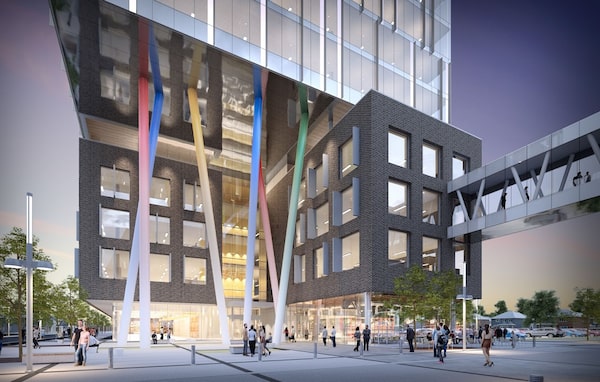
A rendering of Google's future office in Kitchener, Ont.Supplied
After a historic run for office demand over the past decade, vacancies in Canada’s largest markets are increasing due to the effects of COVID-19. In the short-term, organizations based in major centres are looking to sublet space in small- and medium-sized communities, where increasing numbers of people are choosing to live. Kitchener, Waterloo and Cambridge, known as the Tri-Cities area, in Southwestern Ontario, is one of the hottest markets poised to take advantage of this trend.
Iain Klugman, chief executive at startup incubator Communitech Corp., which recently renewed its lease at 151 Charles St. W. in downtown Kitchener for five years and currently employs 10 staff from out-of-town, including a vice-president who lives in Winnipeg, says he’s not certain about anything, except that “we will not go back to the workplace we had. This creates opportunity for communities who, in the past, could not compete, and that’s a good thing – to have broad-based growth across the province, not just in large metropolitan areas like Toronto.”
In terms of attracting talent and driving economic growth to the Tri-Cities, look no further than Google, which has had an office in downtown Kitchener since 2006. In February, the California-based tech giant announced plans to build three new Canadian offices, including one in Kitchener.
“As the Toronto-Waterloo corridor continues to be a global centre of tech talent and innovation, it’s the perfect place to expand our footprint, and help grow the next generation of founders in Canada,” Steve Woods, engineering and Waterloo site lead for Google Canada, said in a press release at the time of the announcement.
Google will be the flagship tenant of Phase 3 of the Breithaupt Block, an 11-storey building located across the street from Google’s downtown home. Once completed, the offices will accommodate new Google employees as well as the first Google for Startups Accelerator.
The new building will bring seating capacity to 3,000, more than doubling Google’s current presence in the Tri-Cities region. Despite the pandemic, expansion plans are still in the works, with a target opening date at the end of 2022, confirmed company spokesperson Zaitoon Murji.
Meanwhile, Perimeter Development Corp. signed on its biggest tenant, international law firm Gowling WLG, for its new six-storey, LEED Gold Class A building, also located in Kitchener’s Innovation District. Designed by global firm Diamond Schmitt Architects, 345 King West, which opened in September, is the first Class A building developed in the city in 25 years and offers tenants more than 125,000 square feet of office space.
“The building provides organizations a great canvas to create their workplace of the future,” explains Craig Beattie, Perimeter’s CEO, “especially those looking to get out of the big city. [Gowling’s] move to our new Class A building is part of their growth strategy to improve their workplace environment [which] helps attract the best talent. Their game plan fits in well with the hub-and-spoke trend.”
Others who recently set up shop in Waterloo Region include: tech software companies ApplyBoard and Vidyard as well as medical device company Intellijoint Surgical. This trio of tenants are the types of clients (along with logistics/distribution firms and co-working companies) driving the demand for commercial office property, not just in the Tri-Cities area, but across Canada, according to a Mordor Intelligence report, Commercial Real Estate Market in Canada – Growth, Trends, and Forecasts (2020-2025).
The lingering economic effects of COVID-19 are slowing the demand for commercial office space but driving a surge in subletting. According to a recent CBRE third-quarter report, the amount of available sublet space in Canada increased to 1.6 million square feet, up from the second quarter. Likewise, in Waterloo Region, the office vacancy rates rose to almost 7 per cent in the third quarter, up slightly from 6.3 per cent in the previous quarter.
CBRE spokesperson Ryan Starr explains that, while Waterloo Region’s office market saw vacancy increase, sublease availabilities simultaneously decreased by more than half and now represent 2.4 per cent of all vacant space. “This highlights preferences for shorter-term lease agreements as companies adapt to new working conditions.”
Since January, the Tri-Cities office market has recorded 299,000 square feet of space leased versus space vacated or supplied. New towers continue to be leased as they’re built. The area’s development pipeline boasts 315,000 square feet of office space under construction, of which well over half is expected to be completed by the end of the year and plans to build an additional 580,000 square feet of office space are under way.
“Given Waterloo Region’s growing tech sector, this development will help meet the expected demand for office space,” Mr. Starr adds.
According to Colliers International associate vice-president John Lind, who moved from Toronto to Waterloo Region 13 years ago, “there is a pent-up demand for office space here, but we are currently in a ‘wait and see’ situation. No one is ready yet to commit to a long-term lease.”
Duncan McLean, vice-president of business development for CMA Realty in Kitchener, concurs. “There are opportunities in the commercial marketplace for sublets, but landlords will have to re-evaluate their rent positions or repurpose some of their properties,” he says. “One thing is for sure: they won’t be doing business the same way going forward. Some are trying to get ahead of it; some don’t want to believe it is real.”